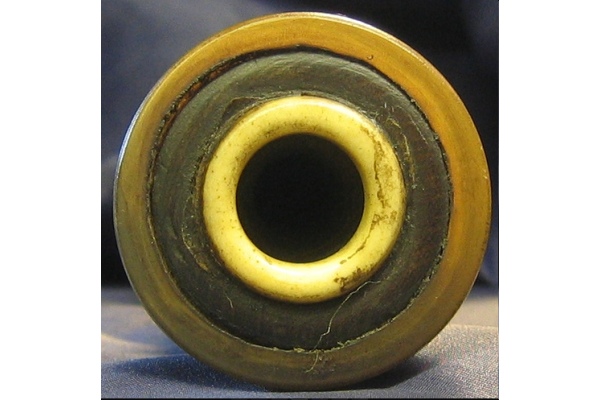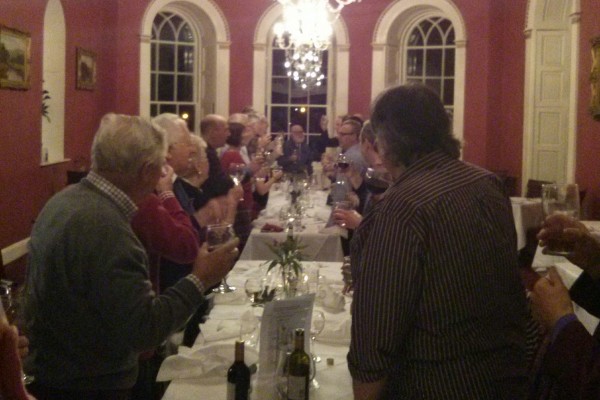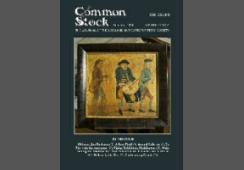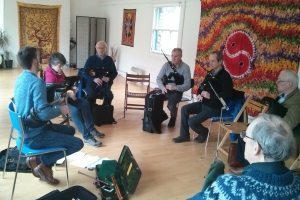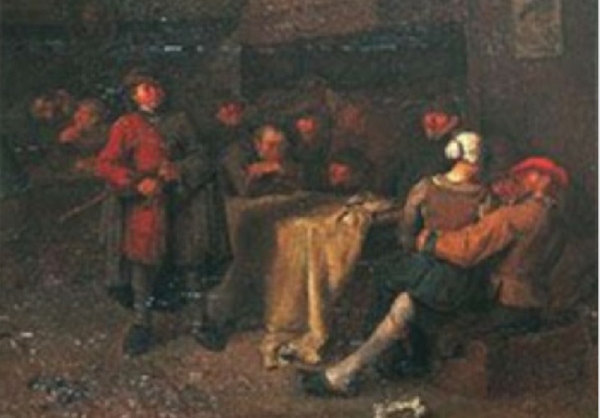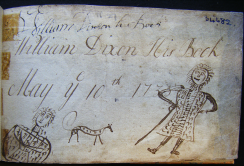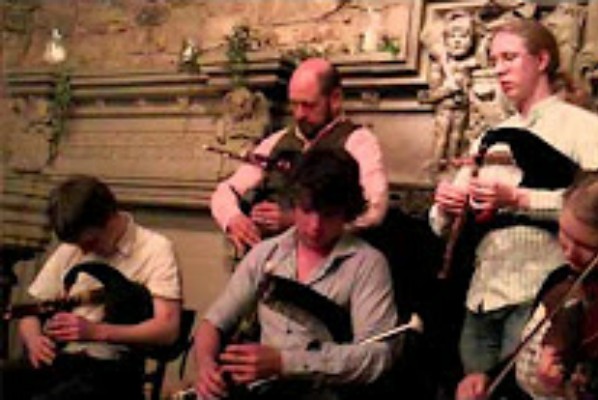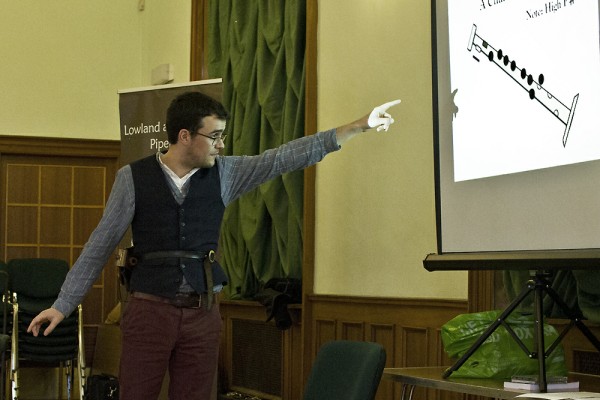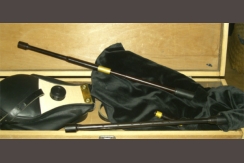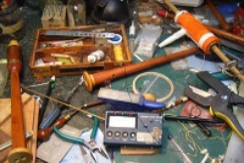
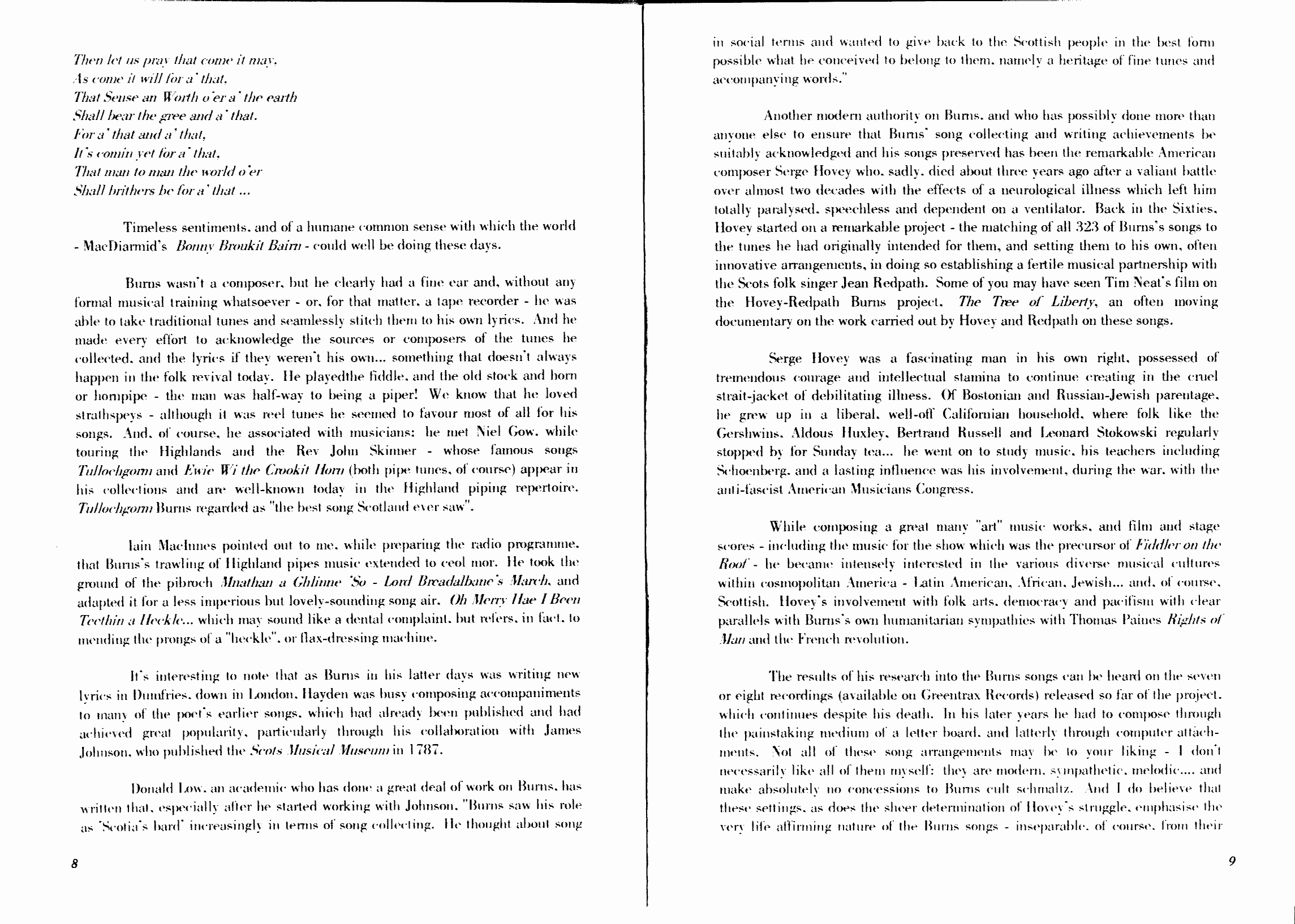
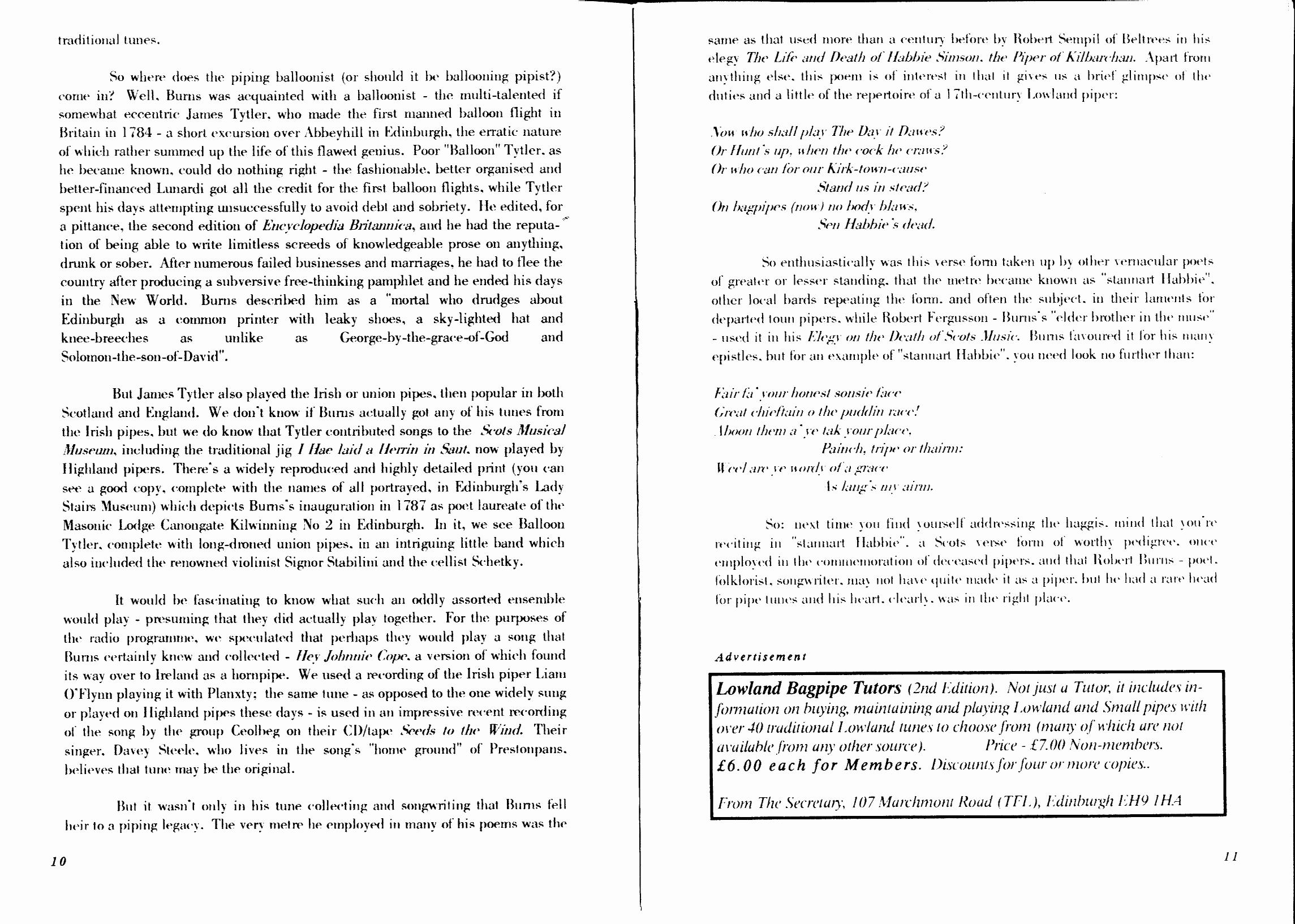
Jim Gilchrist first put this together as an Immortal Memory for the LBPS’s first Burns supper in January of last year. He was later:invited by BBC Scotland to develop it for a half-hour programme broadcast on Burns night this January - "He Screwed the Pipes and Gart them Skirl", produced by
Jain MacInnes, in which Iain, on small pipes, fiddler John Martin and singer Andy Hunter played and sang Lowland pipe tunes as adapted by Burns.
This article combines elements of the two.
MANY of you will know the old 9/8 jig Rattlin Roarin Willie - as a song, a Burns song. It's an appropriate song, perhaps, for a convivial collogue such as a Burns Supper. So let’s take a digression to look at its origins: there are a few such digressions in this article, which will also touch upon an American composer of Russian-Jewish extraction and a piping balloonist.... it will be, in fact, a bit like that Irish country road which in Flann O'Brien's immortal expression, wound its way through “places which, strictly speaking, weren't on its way".
Rattlin Roarin Willie has its origins in the days of the late 18th Century when the night life of the Auld Toun of Edinburgh went on in various howfs, many of which hosted drinking and carousing clubs, often with intriguing names such as the Cape Club, the Easy Club, the
Dirty Club, the Black Wigs, the Assembly of Birds, the Humdrum Club, the Stoic, the Knights of the Cap and Feather... It was a period during which, in the words of Robert Chambers, "Intemperance was the rule to such a degree that the exception could hardly be said to exist.”
According to Burns, "the hero of this chant was one of the worthiest follows in the world - William Dunbar Esq. Writer to the Signet and Colonel of the Crochallan Corps, a club of wits who took that title al the time of raising the fencible regiments.” Now the Crochallan Fencibles met in the famous or infamous Dawney Douglas's Tavern, which was in Anchor Close off the High Street. The proprietor, Dawney Douglas, had an old Gaelic song he used to sing called Crochallan, hence the club's name, and the last verse, which Burns added on to pre-existing verses of the song...
As I cam by Crochallan I cannily keekit ben:
Rattlin Roarin Willie was sittin at yon board end,
Sittin at yon board end and amang guid company, Oh Rattlin Roarin Willie ye're welcome hame to me.
It may be a song about a fiddler, but the traditional tune is a 9/8 pipe jig of the kind which seems to have been commonplace in Lowland/Border piping. And the more we look into the 320-plus songs that Robert Burns is reckoned to have written, adapted or collected - all of them using already established traditional tunes - the more we realise that there’s more in the Burns cult to interest a piper than just the statutory Com Rigs medleys and that business of piping in the haggis.
Burns' best-known reference to bagpipes has become a classic among misinformed piping clichés: the line He Screwed the Pipes and gart them skirl comes, of course. from Tam O’ Shanter, and while that’s a fair turn of phrase for tuning up, it’s followed by The piper loud and louder blew... Even a Satanic piper would know that, if your pipes are getting louder as you play, something's far wrong.
And Burns really should have known better, steeped as he was in his country’s folk music. And he loved pipe music - Highland and Lowland. And amid what all too often tends to be a lot of Burns Nicht fantoosherie (apart from the LBPS event, of course!), surprisingly little tends to be made of the fact that even if Burns had never had a stroke of poetry published in his life, we would still owe him a tremendous debt to this day for his work in what he collected and saved from Scotland's musical tradition, quite consciously saving these tunes and songs in the face of the major social and economic upheavals affecting his society.
Everybody knows Ae Fond Kiss, Auld Lang Syne, Mary Morrison, etc, but take a look at the huge song sections of any edition of Burns’ collected works... And look also at the tunes he used for them. Many of them are pipe tunes, many of them of particular interest to a Lowland and Border Pipers’ Society... Maggie Lauder, Brose and Butter, The Mill, Mill Oh, Hey Ca’ Thro, Jacky Latin, Robin Shure in Hairst, Johnny Cock up your Beaver, I’ll Gang Nae’ Mair tae Yon Toun..Those involved in the cauld-wind pipes revival have good cause to be grateful to him.
If Burns kent a good tune. he wasn't averse to using it more than once, either for his “respectable”, widely published songs or for his many bawdy songs which found their way into The Merry Muses. He used the old tune Hey Tutti Tatti for a song Landlady Count the Lawin’ and if that means nothing to you, he went on to use it again for Scots Wha Hae. The traditional reel tune For A’ That he used to find effect for the bard’s song in the Jolly Beggars cantata then, never one to waste a fine tune, guaranteed its place in posterity by writing yet another set of words for it...
Then let us pray that come it may.
As come it will for a’ that.
That Seuse an Worth o’er a the earth Shall bear the gree and a’ that.
For a’ that and a’ that,
It’s comin yet for a’ that,
That man to man the world o'er Shall brithers be for a’ that...
Timeless sentiments, and of a humane common sense with which the world - MacDiarmid’s Bonny Broukit Bairn - could well be doing these days.
Burns wasn’t a composer, but he clearly had a fine ear and, without any formal musical training whatsoever - or, for that matter, a tape recorder - he was able to take traditional tunes and seamlessly stitch them to his own lyrics. And he made every effort to acknowledge the sources or composers of the tunes he collected, and the lyrics if they weren't his own... something that doesn’t always happen in the folk revival today. He played the fiddle. and the old stock and horn or hornpipe - the man was half-way to being a piper! We know that he loved strathspeys - although it was reel tunes he seemed to favour most of all for his songs. And. of course, he associated with musicians: he met Niel Gow, while touring the Highlands and the Rev John Skinner - whose famous songs Tullochgorm and Ewie Wi’ the Crookit Horn (both pipe tunes, of course) appear in his collections and are well-known today in the Highland piping repertoire. Tullochgorm Burns regarded as “the best song Scotland ever saw".
Iain MacInnes pointed out to me, while preparing the radio programme, that Burns' trawling of Highland pipes music extended to ceol mor. He took the ground of the pibroch Mnathan a Ghlinne ‘So - Lord Breadalbane’s March, and adapted it for a less imperious but lovelysounding song air, Oh Merry Hae I Been Teethin a Heckle.. which may sound like a dental complaint, but refers, in fact, to mending the prongs of a “heckle", or flax-dressing machine.
It's interesting to note that as Burns in his latter days was writing new lyrics in Dumfries, down in London, Hayden was busy composing accompaniments to many of the poet's earlier songs. which had already been published and had achieved great popularity, particularly through his collaboration with James Johnson, who published the Scots Musical Museum in 1787.
Donald Low, an academic who has done a great deal of work on Burns, has written that, especially after he started working with Johnson, “Burns saw his role as ‘Scotia's bard’ increasingly in terms of song collecting. He thought about song in social terms and wanted to give back to the Scottish people in the best form possible what he conceived to belong to them, namely a heritage of fine tunes and accompanying words.”
Another modern authority on Burns, and who has possibly done more than anyone else to ensure that Burn’ song collecting and writing achievements be suitably acknowledged and and his songs preserved has been the remarkable American composer Serge Hovey who, sadly, died about three years ago after a valiant battle over almost two decades with the effects of a neurological illness which left him totally paralysed, speechless and dependent on a ventilator. Back in the Sixties, Hovey started on a remarkable project - the matching of all 323 of Burns’ songs to the tunes he had originally intended for them, and setting them to his own, often innovative arrangements, in doing so establishing a fertile musical partnership with the Scots folk singer Jean Redpath. Some of you may have seen Tim Neat’s film on the Hovey-Redpath Burns project, The Tree of Liberty, an often moving documentary on the work carried out by Hovey and Redpath on these songs.
Serge Hovey was a fascinating man in his own right, possessed of tremendous courage and intellectual stamina to continue creating in the cruel strait-jacket of debilitating illness. Of Bostonian and Russian-Jewish parentage, he grew up in a liberal, well-off Californian household, where folk like the Gershwins, Aldous Huxley, Bertrand Russell and Leonard Stokowski regularly stopped by for Sunday tea... he went on to study music, his teachers including Schoenberg, and a lasting influence was his involvement, during the war, with the anti-fascist American Musicians Congress.
While composing a great many “art” music works, and film and stage scores - including the music for the show which was the precursor of Fiddler on the Roof - he became intensely interested in the various diverse musical cultures within cosmopolitan America - Latin American, African, Jewish... and, of course, Scottish. Hovey’s involvement with folk arts., democracy and pacifism have clear parallels with Burns' own humanitarian sympathies with Thomas Paine’s Rights of Man and the French revolution.
The results of his research into the Burns songs ean be heard on the seven or eight recordings (available on Greentrax Records) released so far of the project, which continues despite his death. In his later years he had to compose through the painstaking medium of a letter board. and latterly through computer attachments. Not all of these song arrangements may be to your liking - I don't necessarily like all of them myself: they are modern, sympathetic, melodic... and make absolutely no concessions to Burns cult schmaltz. And I do believe that these settings, as does the sheer determination of Hovey’s struggle, emphasise the very life affirming nature of the Burns songs - inseparable, of course, from their traditional tunes.
So where does the piping balloonist (or should it be ballooning pipist?) come in? Well,
Burns was acquainted with a balloonist - the multi-talented if somewhat eccentric James
Tytler, who made the first manned balloon flight in Britain in 1784 - a short excursion over Abbeyhill in Edinburgh, the erratic nature of which rather summed up the life of this flawed genius. Poor "Balloon" Tytler, as he became known, could do nothing right - the fashionable. better organised and better-financed Lunardi got all the credit for the first balloon flights, while Tytler spent his days attempting unsuccessfully to avoid debt and sobriety. He edited, for a pittance, the second edition of Encyclopedia Britannica, and he had the reputa- tion of being able to write limitless screeds of knowledgeable prose on anything, drunk or sober. After numerous failed businesses and marriages, he had to flee the country after producing a subversive free-thinking pamphlet and he ended his days in the New World. Burns described him as a “mortal who drudges about Edinburgh as a common printer with leaky shoes, a sky-lighted hat and knee-breeches as unlike as George-by-the-grace-of-God and Solomon-the-son-of- David".
But James Tytler also played the Irish or union pipes. then popular in both Scotland and England. We don’t know if Burns actually got any of his tunes from the Irish pipes, but we do know that Tytler contributed songs to the Scots Musical Museum, including the traditional jig I Hae laid a Herrin’ in Saut, now played by Highland pipers. There’s a widely reproduced and highly detailed print (you can see a good copy, complete with the names of all portrayed, in Edinburgh's Lady Stairs Museum) which depicts Burn’s inauguration in 1787 as poet laureate of the Masonic Lodge Canongate Kilwinning No 2 in Edinburgh. In it, we see Balloon Tytler, complete with long-droned union pipes, in an intriguing little band which also included the renowned violinist Signor Stabilini and the cellist Schetky.
It would be fascinating to know what such an oddly assorted ensemble would play - presuming that they did actually play together. For the purposes of the radio programme, we speculated that perhaps they would play a song that Burns certainly knew and collected - Hey Johnnie Cope, a version of which found its way over to lreland as a hornpipe. We used a recording of the Irish piper Liam O'Flynn playing it with Planxty; the same tune ~ as opposed to the one widely sung or played on Ilighland pipes these days - is used in an impressive recent recording of the song by the group Ceolbeg on their CD/tape Seeds to the Wind. Their singer, Davey Steele, who lives in the song's "home ground” of Prestonpans, believes that tune may be the original.
But it wasn't only in his tune collecting and songwriting that Burns fell heir to a piping legacy. The very metre he employed in many of his poems was the same as that used more than a century before by Robert Sempil of Beltrees in his elegy The Life and Death of Habbie Stimson, the Piper of Kilbarchan. Apart from anything else, this poem is of interest in that it gives us a brief glimpse of the duties and a little of the repertoire of a 17th-century Lowland piper:
Now who shall play The Day it Dawes?
Or Hunt's up, when the cock he craws?
Or who can for our Kirk-town-cause
Stand us in stead?
On bagpipes (now) no body blaws,
Sen Habbie’s dead.
So enthusiastically was this verse form taken up by other vernacular poets of greater or lesser standing, that the metre became known as “stannart Habbie", other local bards repeating the form, and often the subject, in their laments for departed toun pipers, while Robert Fergusson - Burns's “elder brother in the muse” -used it in his Elegy on the Death of Scots Music. Burns favoured it for his many epistles, but for an example of “stannart Habbie". you need look no further than:
Fair fa’ your honest sonsie face
Great chieftain o the puddin race!
Aboon then a ye tak your place,
Painch, tripe or thairn:
Weel are ye wordy of a grace
As lang’s my airm.
So: next time you find yourself addressing the haggis, mind that you're reciting in "stannart Habbie", a Scots verse form of worthy pedigree, once employed in the commemoration of deceased pipers, and that Robert Burns - poet, folklorist, songwriter, may not have quite made it as a piper. but he had a rare head for pipe tunes and his heart, clearly, was in the right place.
